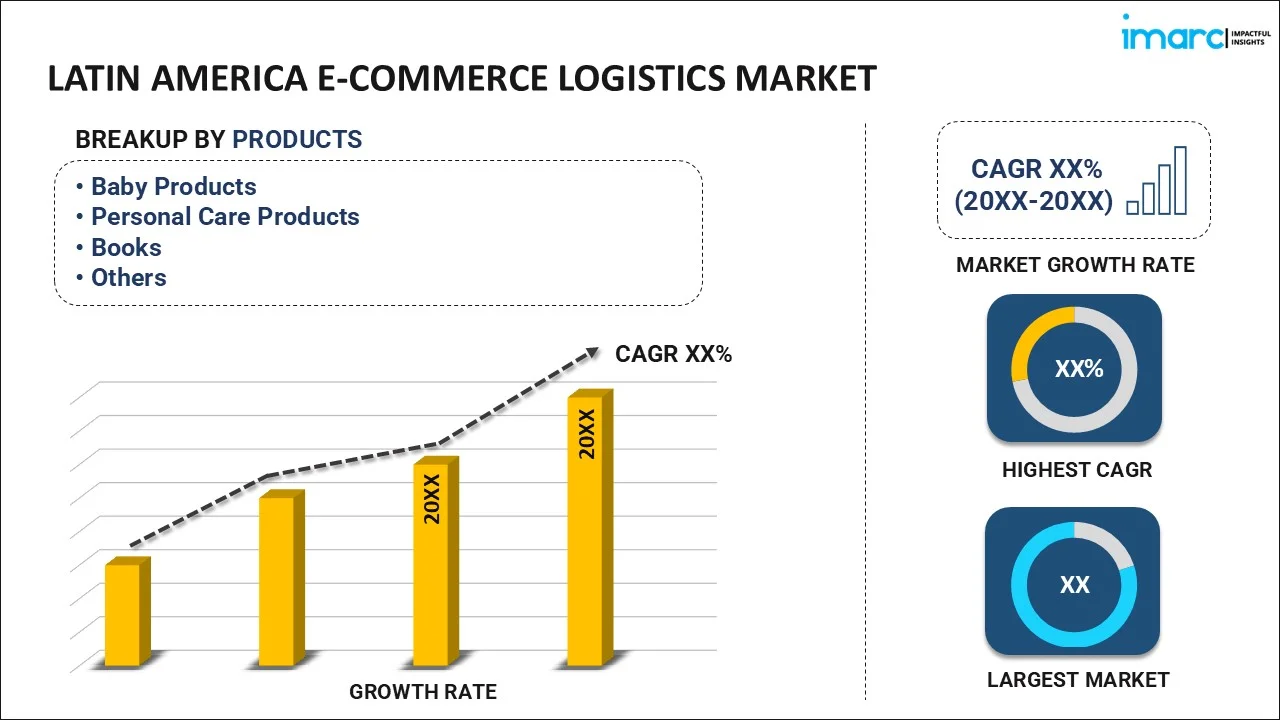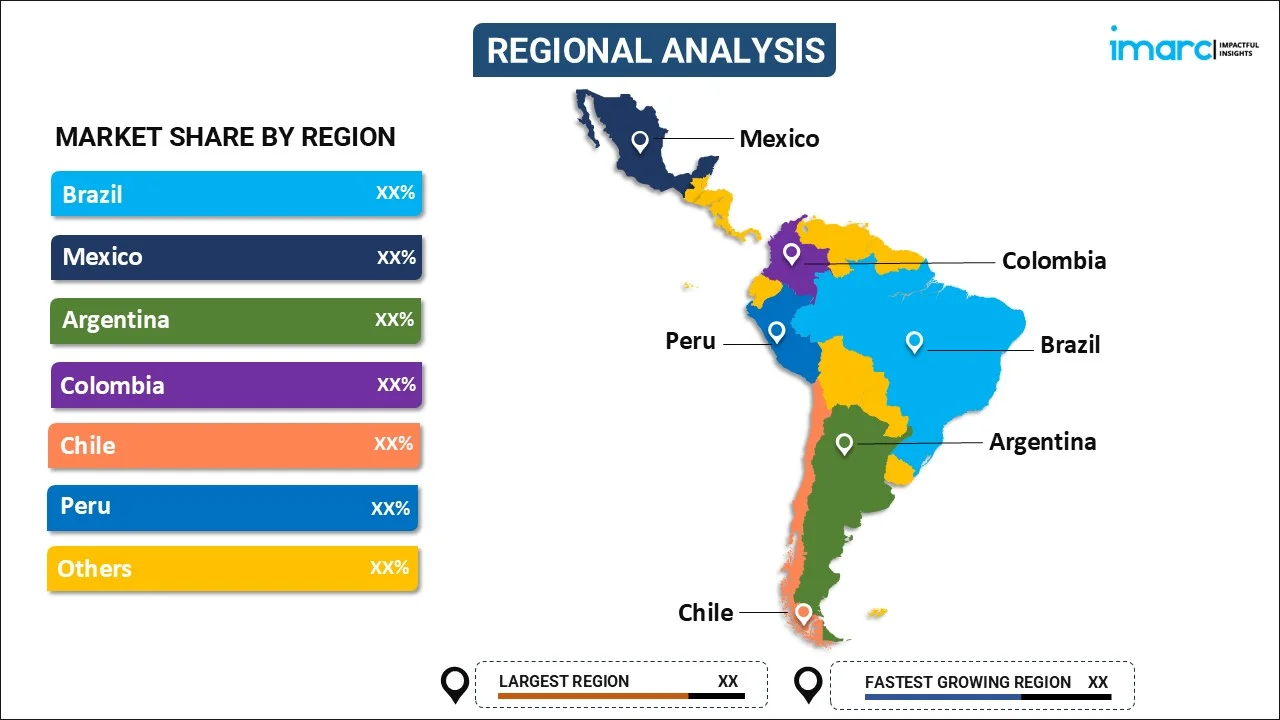
Latin America E-Commerce Logistics Market Size, Share, Trends and Forecast by Product, Service Type, Operational Area, and Region, 2025-2033
Latin America E-Commerce Logistics Market Overview:
The Latin America e-commerce logistics market size reached USD 30.58 Billion in 2024. Looking forward, IMARC Group expects the market to reach USD 76.86 Billion by 2033, exhibiting a growth rate (CAGR) of 9.97% during 2025-2033. The Latin America e-commerce logistics market is driven by increasing online consumer demand, rising smartphone and internet penetration, enhanced digital payment adoption, significant investments in logistics infrastructure, expanding last-mile delivery networks, and government initiatives to improve trade regulations, ensuring faster, cost-effective, and more efficient supply chain operations across the region.
|
Report Attribute
|
Key Statistics
|
|---|---|
|
Base Year
|
2024 |
|
Forecast Years
|
2025-2033
|
|
Historical Years
|
2019-2024
|
| Market Size in 2024 | USD 30.58 Billion |
| Market Forecast in 2033 | USD 76.86 Billion |
| Market Growth Rate (2025-2033) | 9.97% |
Latin America E-Commerce Logistics Market Trends:
Surge in Online Consumer Activity
The online environment in Latin America has seen an incredible shift, with online consumer behavior growing at a considerable rate. This has been brought about by the common use of Internet services and mobile phones, thereby making online purchases more convenient for the masses. Online spending in Latin America stood at more than USD 71 Billion in 2018, a 15% growth compared to the preceding year. Chile was a case in point, with online business surpassing USD 5 Billion, making it the country with the most per capita e-commerce transactions in the region. The COVID-19 pandemic further pushed this trend, with shoppers shifting to online platforms as a means of shopping because of lockdowns and social distancing. Latin America had a 37% e-commerce growth in sales in 2020, reaching USD 85 Billion. The growth of online consumers has thus put in place a critical need for effective and trusted e-commerce logistics solutions. Firms are now emphasizing improving their supply chain capabilities in order to address customer demands for quicker and more reliable deliveries.
Investments in Logistics Infrastructure
Latin American countries have been working together to invest and enhance logistics infrastructure across the region in order to facilitate the growing e-commerce industry. Due to the understanding of the key role played by effective logistics in e-commerce, both governments and private companies have taken the lead in developing projects to improve transportation networks, warehouses, and delivery services. In Brazil, the e-commerce industry hit RUSD196.1 Billion in 2023, a 4.8% growth from RUSD187.89 Billion in 2022. The increase is a sign of the significant role that strong logistics networks play in coping with the rising number of online orders. Firms such as MercadoLibre have gone a long way in enhancing their logistics. MercadoLibre posted a net revenue of USD6.1 Billion in the fourth quarter of 2024, with sales increasing by 8% due to robust performance in Brazil. This success was partly due to growing logistics efficiency, particularly in Mexico. Additionally, the leading 20 logistics players in Latin America have posted a 25% average revenue growth during the first quarter of 2024, demonstrating strong growth in the logistics industry.
Latin America E-commerce Logistics Market Segmentation:
IMARC Group provides an analysis of the key trends in each segment of the market, along with forecasts at the region/country level for 2025-2033. Our report has categorized the market based on product, service type, and operational area.
Product Insights:

- Baby Products
- Personal Care Products
- Books
- Home Furnishing Products
- Apparel Products
- Electronics Products
- Automotive Products
- Others
The report has provided a detailed breakup and analysis of the market based on the product. This includes baby products, personal care products, books, home furnishing products, apparel products, electronics products, automotive products, and others.
Service Types Insights:
- Transportation
- Warehousing
A detailed breakup and analysis of the market based on the service type have also been provided in the report. This includes transportation and warehousing.
Operational Area Insights:
- International
- Domestic
A detailed breakup and analysis of the market based on the operational area have also been provided in the report. This includes international and domestic.
Regional Insights:

- Brazil
- Mexico
- Argentina
- Colombia
- Chile
- Peru
- Others
The report has also provided a comprehensive analysis of all the major regional markets, which include Brazil, Mexico, Argentina, Colombia, Chile, Peru, and others.
Competitive Landscape:
The market research report has also provided a comprehensive analysis of the competitive landscape. Competitive analysis such as market structure, key player positioning, top winning strategies, competitive dashboard, and company evaluation quadrant has been covered in the report. Also, detailed profiles of all major companies have been provided.
Latin America E-Commerce Logistics Market News:
- June 2024: Yango, a worldwide technology leader, launched Yango Tech in Mexico. The project sought to provide patented technologies and knowledge to e-commerce companies and physical stores in the food industry. Yango Tech aimed to enhance operational efficiency while also assisting traditional retailers in transitioning to online platforms.
- May 2024: DHL Group's contract logistics sector partnered with Brazilian startup Levu Air Cargo to launch a private air freight service. This project aimed to provide a more reliable option than commercial passenger airlines and trucking, particularly for the domestic shipping of valuable goods in industries such as automotive and healthcare.
Latin America E-Commerce Logistics Market Report Coverage:
| Report Features | Details |
|---|---|
| Base Year of the Analysis | 2024 |
| Historical Period | 2019-2024 |
| Forecast Period | 2025-2033 |
| Units | Billion USD |
| Scope of the Report |
Exploration of Historical Trends and Market Outlook, Industry Catalysts and Challenges, Segment-Wise Historical and Future Market Assessment:
|
| Products Covered | Baby Products, Personal Care Products, Books, Home Furnishing Products, Apparel Products, Electronics Products, Automotive Products, Others |
| Service Types Covered | Transportation, Warehousing |
| Operational Areas Covered | International, Domestic |
| Regions Covered | Brazil, Mexico, Argentina, Colombia, Chile, Peru, Others |
| Customization Scope | 10% Free Customization |
| Post-Sale Analyst Support | 10-12 Weeks |
| Delivery Format | PDF and Excel through Email (We can also provide the editable version of the report in PPT/Word format on special request) |
Key Questions Answered in This Report:
- How has the Latin America e-commerce logistics market performed so far and how will it perform in the coming years?
- What is the breakup of the Latin America e-commerce logistics market on the basis of product?
- What is the breakup of the Latin America e-commerce logistics market on the basis of service type?
- What is the breakup of the Latin America e-commerce logistics market on the basis of operational area?
- What are the various stages in the value chain of the Latin America e-commerce logistics market?
- What are the key driving factors and challenges in the Latin America e-commerce logistics market?
- What is the structure of the Latin America e-commerce logistics market and who are the key players?
- What is the degree of competition in the Latin America e-commerce logistics market?
Key Benefits for Stakeholders:
- IMARC’s industry report offers a comprehensive quantitative analysis of various market segments, historical and current market trends, market forecasts, and dynamics of the Latin America e-commerce logistics market from 2019-2033.
- The research report provides the latest information on the market drivers, challenges, and opportunities in the Latin America e-commerce logistics market.
- Porter's five forces analysis assist stakeholders in assessing the impact of new entrants, competitive rivalry, supplier power, buyer power, and the threat of substitution. It helps stakeholders to analyze the level of competition within the Latin America e-commerce logistics industry and its attractiveness.
- Competitive landscape allows stakeholders to understand their competitive environment and provides an insight into the current positions of key players in the market.
Need more help?
- Speak to our experienced analysts for insights on the current market scenarios.
- Include additional segments and countries to customize the report as per your requirement.
- Gain an unparalleled competitive advantage in your domain by understanding how to utilize the report and positively impacting your operations and revenue.
- For further assistance, please connect with our analysts.
 Inquire Before Buying
Inquire Before Buying
 Speak to an Analyst
Speak to an Analyst
 Request Brochure
Request Brochure
 Request Customization
Request Customization




.webp)




.webp)












